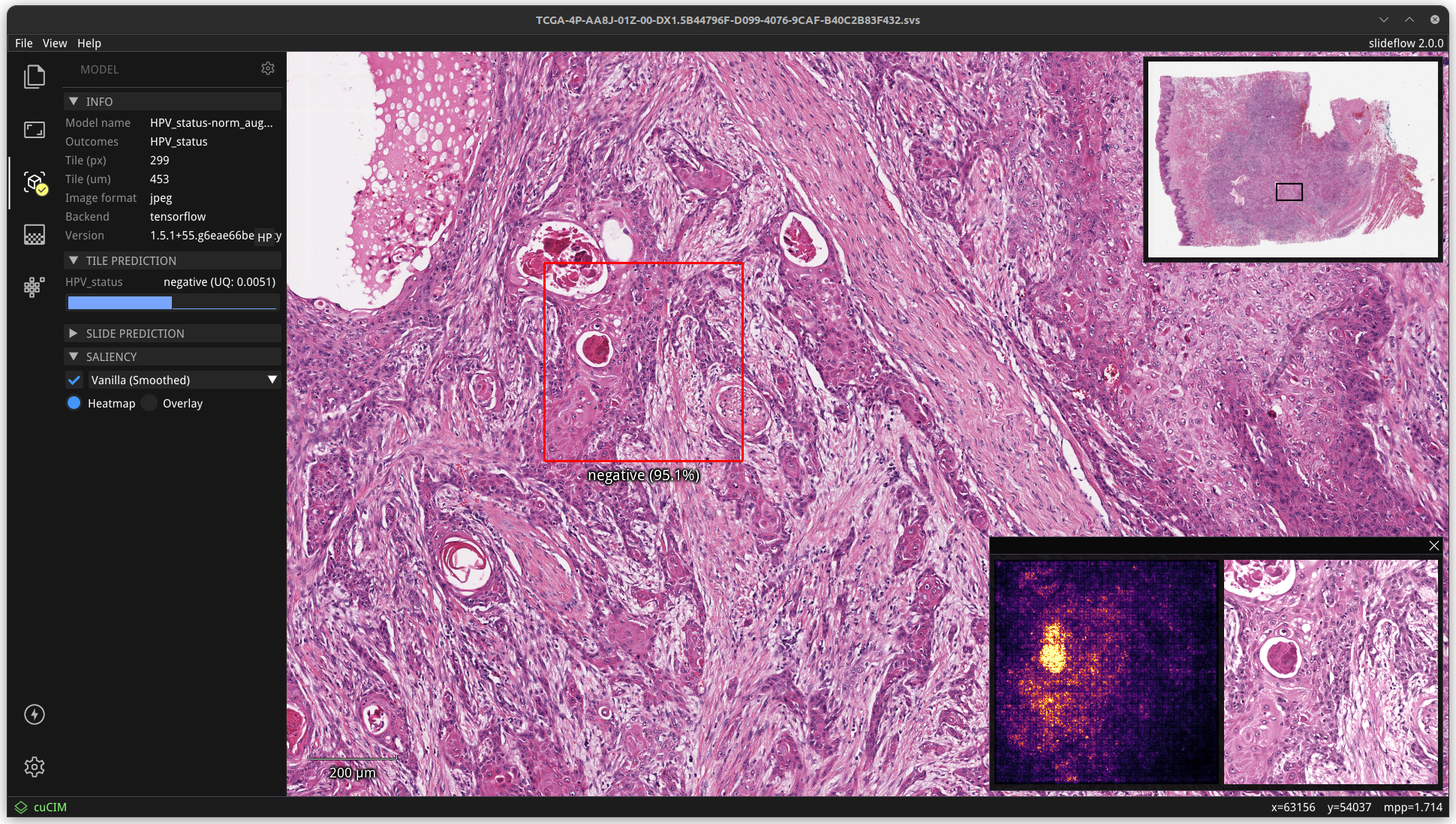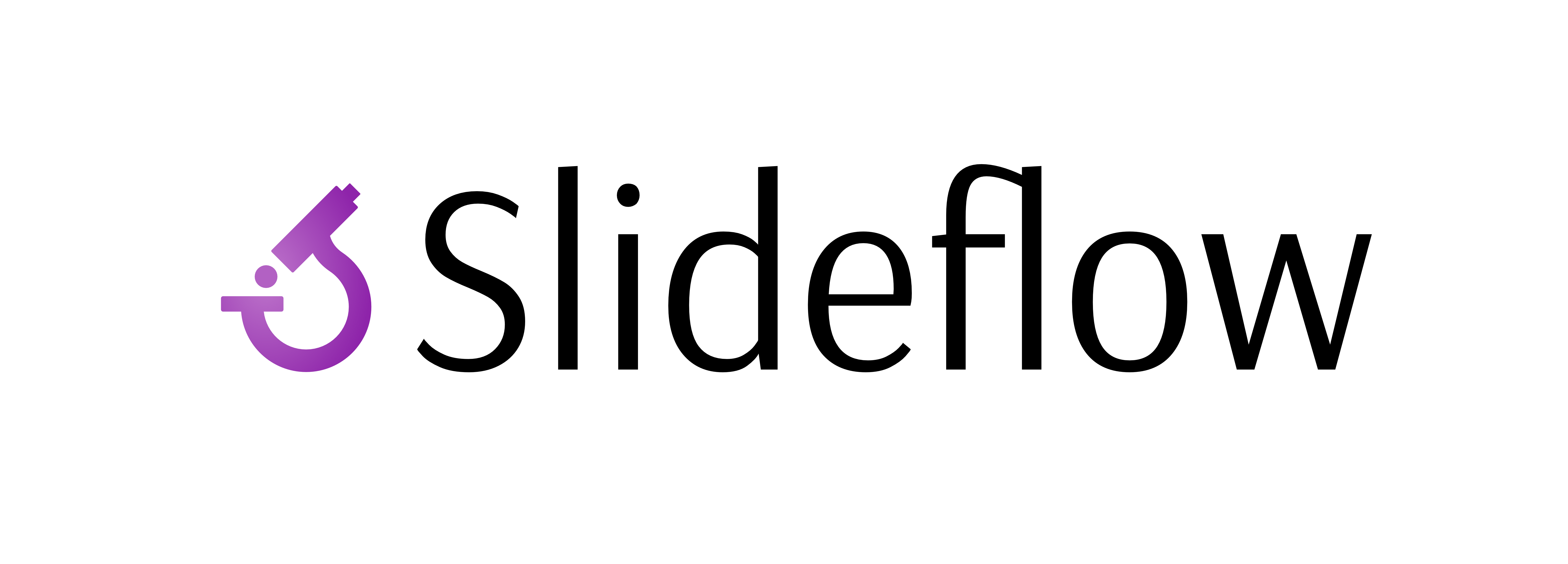Deep learning tools for digital histology
Project description
Slideflow is a deep learning library for digital pathology that provides a unified API for building, training, and testing models using Tensorflow or PyTorch.
Slideflow includes tools for whole-slide image processing and tile extraction, customizable deep learning model training with dozens of supported architectures, explainability tools including heatmaps, mosaic maps, GANs, and saliency maps, analysis of activations from model layers, uncertainty quantification, and more. A variety of fast, optimized whole-slide image processing tools are included, including background filtering, blur/artifact detection, stain normalization, and efficient storage in *.tfrecords format. Model training is easy and highly configurable, with an easy drop-in API for training custom architectures. For external training loops, Slideflow can be used as an image processing backend, serving an optimized tf.data.Dataset or torch.utils.data.DataLoader to read and process slide images and perform real-time stain normalization.

Slideflow has been used by:
- Dolezal et al, Modern Pathology, 2020
- Rosenberg et al, Journal of Clinical Oncology [abstract], 2020
- Howard et al, Nature Communications, 2021
- Dolezal et al Nature Communications, 2022
- Storozuk et al, Modern Pathology [abstract], 2022
- Partin et al [arXiv], 2022
- Dolezal et al [abstract], 2022
- Howard et al [bioRxiv], 2022
- Dolezal et al [arXiv], 2022
Full documentation with example tutorials can be found at slideflow.dev.
Requirements
- Python >= 3.7 (<3.10 if using cuCIM)
- Tensorflow 2.5-2.9 or PyTorch 1.9-1.12
Optional
- Libvips >= 8.9 (alternative slide reader, adds support for *.scn, *.mrxs, *.ndpi, *.vms, and *.vmu files).
- QuPath (for pathologist ROIs)
- Linear solver (for preserved-site cross-validation)
- CPLEX 20.1.0 with Python API
- or Pyomo with Bonmin solver
Installation
Slideflow can be installed with PyPI, as a Docker container, or run from source.
Method 1: Install via pip
pip3 install --upgrade setuptools pip wheel
pip3 install slideflow[cucim] cupy-cuda11x
The cupy package name depends on the installed CUDA version; see here for installation instructions. cupy is not required if using Libvips.
Method 2: Docker image
Alternatively, pre-configured docker images are available with OpenSlide/Libvips and the latest version of either Tensorflow and PyTorch. To install with the Tensorflow backend:
docker pull jamesdolezal/slideflow:latest-tf
docker run -it --gpus all jamesdolezal/slideflow:latest-tf
To install with the PyTorch backend:
docker pull jamesdolezal/slideflow:latest-torch
docker run -it --shm-size=2g --gpus all jamesdolezal/slideflow:latest-torch
Method 3: From source
To run from source, clone this repository, install the conda development environment, and build a wheel:
git clone https://github.com/jamesdolezal/slideflow
cd slideflow
conda env create -f environment.yml
conda activate slideflow
python setup.py bdist_wheel
pip install dist/slideflow* cupy-cuda11x
Configuration
Deep learning (Tensorflow vs. PyTorch)
Slideflow supports both Tensorflow and PyTorch, defaulting to Tensorflow if both are available. You can specify the backend to use with the environmental variable SF_BACKEND. For example:
export SF_BACKEND=torch
Slide reading (cuCIM vs. Libvips)
By default, Slideflow reads whole-slide images using cuCIM. Although much faster than other openslide-based frameworks, it supports fewer slide scanner formats. Slideflow also includes a Libvips backend, which adds support for *.scn, *.mrxs, *.ndpi, *.vms, and *.vmu files. You can set the active slide backend with the environmental variable SF_SLIDE_BACKEND:
export SF_SLIDE_BACKEND=libvips
Getting started
Slideflow experiments are organized into Projects, which supervise storage of whole-slide images, extracted tiles, and patient-level annotations. The fastest way to get started is to use one of our preconfigured projects, which will automatically download slides from the Genomic Data Commons. Download one of our dataset folders, and supply the *.json file to the project creation function:
import slideflow as sf
P = sf.project.create(
'/project/destination',
cfg='datasets/thyroid_brs/thyroid_brs.json',
download=True,
md5=True
)
After the slides have been downloaded and verified, you can skip to Extract tiles from slides.
Alternatively, to create a new custom project, create an instance of the slideflow.Project class and supply patient-level annotations in CSV format:
import slideflow as sf
P = sf.Project(
'/project/path',
annotations="/patient/annotations.csv"
)
Once the project is created, add a new dataset source with paths to whole-slide images, tumor Region of Interest (ROI) files [if applicable], and paths to where extracted tiles/tfrecords should be stored. This will only need to be done once.
P.add_source(
name="TCGA",
slides="/slides/directory",
roi="/roi/directory",
tiles="/tiles/directory",
tfrecords="/tfrecords/directory"
)
This step should attempt to automatically associate slide names with the patient identifiers in your annotations file. After this step has completed, double check that the annotations file has a slide column for each annotation entry with the filename (without extension) of the corresponding slide.
Extract tiles from slides
Next, whole-slide images are segmented into smaller image tiles and saved in *.tfrecords format. Extract tiles from slides at a given magnification (width in microns size) and resolution (width in pixels) using sf.Project.extract_tiles():
P.extract_tiles(
tile_px=299, # Tile size, in pixels
tile_um=302 # Tile size, in microns
)
If slides are on a network drive or a spinning HDD, tile extraction can be accelerated by buffering slides to a SSD or ramdisk:
P.extract_tiles(
...,
buffer="/mnt/ramdisk"
)
Training models
Once tiles are extracted, models can be trained. Start by configuring a set of hyperparameters:
params = sf.ModelParams(
tile_px=299,
tile_um=302,
batch_size=32,
model='xception',
learning_rate=0.0001,
...
)
Models can then be trained using these parameters. Models can be trained to categorical, multi-categorical, continuous, or time-series outcomes, and the training process is highly configurable. For example, to train models in cross-validation to predict the outcome 'category1' as stored in the project annotations file:
P.train(
'category1',
params=params,
save_predictions=True,
multi_gpu=True
)
Evaluation, heatmaps, mosaic maps, and more
Slideflow includes a host of additional tools, including model evaluation and prediction, heatmaps, mosaic maps, analysis of layer activations, and more. See our full documentation for more details and tutorials.
License
This code is made available under the GPLv3 License and is available for non-commercial academic purposes.
Reference
If you find our work useful for your research, or if you use parts of this code, please consider citing as follows:
James Dolezal, Sara Kochanny, & Frederick Howard. (2022). Slideflow: A Unified Deep Learning Pipeline for Digital Histology (1.3.0). Zenodo. https://doi.org/10.5281/zenodo.7183188
@software{james_dolezal_2022_7183188,
author = {James Dolezal and
Sara Kochanny and
Frederick Howard},
title = {{Slideflow: A Unified Deep Learning Pipeline for
Digital Histology}},
month = oct,
year = 2022,
publisher = {Zenodo},
version = {1.3.0},
doi = {10.5281/zenodo.7183188},
url = {https://doi.org/10.5281/zenodo.7183188}
}
Project details
Release history Release notifications | RSS feed
Download files
Download the file for your platform. If you're not sure which to choose, learn more about installing packages.
Source Distributions
Built Distribution
Hashes for slideflow-1.4.3-py3-none-any.whl
| Algorithm | Hash digest | |
|---|---|---|
| SHA256 | 00cb4e19754709cf3170682aeb1092d3600cec5155fd206742e290ab65ec02c0 |
|
| MD5 | bd9efa5d41dde5486939968d76b54489 |
|
| BLAKE2b-256 | 4660325e1c70423ed0654ecf84a2aa4e605d97da58cafefec57e78759ff15080 |















